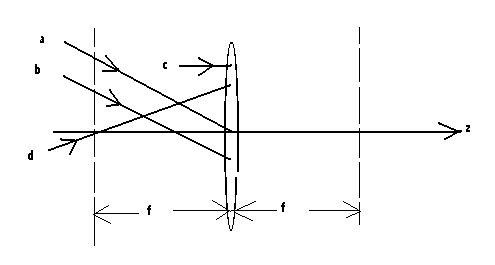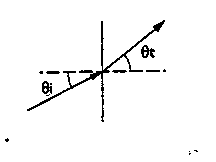 5. The figure below shows rays incident on the left-hand-side of the lens. Show the continuation of the rays on the right-hand-side of the lens.
5. The figure below shows rays incident on the left-hand-side of the lens. Show the continuation of the rays on the right-hand-side of the lens.ELECTRICAL ENGINEERING DEPARTMENT
SOUTHERN METHODIST UNIVERSITY
FIBER OPTIC TELECOMMUNICATIONS
SMU EE 5303 NTU TM-513-N Midterm #1 February 27, 1995
Name (print): ________________________
Location: ________________________
Note #1: each question is worth 5 points.
Note #2: Some of the multiple choice questions may have more than one correct answer listed. If so, circle all of the correct responses for the question.
Note #3: Please print your name at the bottom of the remaining pages.
Note #4: please provide a brief explanation of your answers to multiple-choice type questions.
1. i) What is the frequency of an optical wave that has a free space wavelength of
ii) What is the energy of the photons in this optical wave?
2. When an electromagnetic wave propagates from one medium with an index of refraction of n1 = 1.5 into a second medium with an index of refraction of n2 = 1.0,
a) only the frequency changes,
b) only the wavelength changes,
c) both the frequency and the wavelength change, and/or
d) the frequency and the wavelength both remain the same.
Briefly explain your answer:
3. i) A fiber has an optical loss of 0.1 dB/km. What is the optical loss of a 500 km length of this fiber in units of dBs?
ii) Is the power out the end of the fiber (in part i)
a) equal to the input power,
b) greater than the input power, and/or
c) less than the input power.
Briefly explain your answer to part ii):
4. Two mWs of optical power are coupled into a 5 km length of fiber. The power measured at the end of the fiber is 0.1 mW. What is the loss of this fiber in dB/km?
 5. The figure below shows rays incident on the left-hand-side of the lens. Show the continuation of the rays on the right-hand-side of the lens.
5. The figure below shows rays incident on the left-hand-side of the lens. Show the continuation of the rays on the right-hand-side of the lens.
6. A lens is used to couple the optical power emanating from a semiconductor laser diode into an optical fiber. The full-angle beam divergence (perpendicular to the junction) of the semiconductor laser is 60°. The lens is chosen so that all of the light contained in the 60° full angle beam divergence of the laser is directed into the 12° full angle acceptance cone of the fiber.
i) is the image of the near field aperture of the semiconductor laser magnified or reduced at the input plane of the fiber?
ii) what is the ratio of magnification or reduction in part i)?
7. A light ray proceeds from GaAs (n1 = 3.4) into air (n2 = 1.0). If the incident angle is i = 5°, what is the transmission angle t ?

8. For a critical angle to exist between two media with index n1 and n2,
a) the light ray must be traveling from a low index to a high index,
b) the index difference must greater than tan-1(n2/(n1 + n2)),
c) the loss in the high index medium cannot exceed the loss in the low index medium, and/or
d) the light ray must be traveling from a high index to a low index.
Briefly explain your answer:
9. A semiconductor laser emits optical radiation with a free space wavelength of 1.55 µm. What is the i) frequency, ii) velocity, and iii) wavelength of the optical radiation inside the semiconductor laser? The index of refraction of the semiconductor laser material is 3.45.
10. Recall the homework problems (HW #4, problems 1-4) where we considered pulses made up of three runners who ran at different paces over various distances (data links). If the length of the data link is increased, do you need to slow down or increase the rate of sending pulses (groups of runners) to keep the pulses from overlapping? Why?
11. Again recall the homework problems (HW #4, problems 1-4) where we considered pulses made up of three runners who ran at different paces over various distances. What can you conclude about the relationship between data rate and length of the data link?
12. The normal human voice can be reproduced quite well with a bandwidth of 4 kHz. Why do telephone companies commonly use 64 kbps for a single voice channel?
13. What is the maximum number of phone calls (voice channels) that an optical fiber communications link can carry at a data rate of 10 Gbps (10
10 bps)? Assume that each voice channel requires 64 kbps.
14. The near-field spot size (or optical output aperture) of a semiconductor laser is 1.5 µm perpendicular to the junction and 3 µm parallel to the junction. The free space wavelength of the semiconductor laser is 1.3 µm. Estimate the far-field beam divergence i) perpendicular and ii) parallel to the junction of the laser.
15. Consider a step index optical fiber made of glass. The index of the core region is 1.49 and the index of the cladding region is 1.47. Calculate the range of angles (
c to 90°) that satisfy total internal reflection (TIR) for this fiber.
16. A Gaussian light beam is focused to a spot by a lens. The diameter (2w) of the input beam is 0.5 mm. What is the spot size (2w
o) of the focused spot if the wavelength of the beam is 1.3 µm and the focal length of the lens is 4 mm?
17. i) The numerical aperture of an optical receiver (in air) is 0.25. What is the maximum acceptance angle for incident light rays?
ii) The maximum acceptance angle (half of the acceptance cone full angle) for an optical fiber is 6°. What is the numerical aperture of the fiber?
18. The principle of least time can be used to derive
a) Snell's law,
b) the law of refraction,
c) the law of reflection,
d) the thin lens equation, and/or
e) the best path for a lifeguard to rescue a drowning person
Briefly explain your answer.
19. How far does light with a wavelength of 1.55 µm travel in one microsecond (10
-6 sec)?
20. The velocity with which information propagates on an electromagnetic carrier is given by
a) the group velocity d
/dk for analog signals and the phase velocity /k for digital signalsb) the phase velocity
/kc) the group velocity d
/dk for digital signals and the phase velocity /k for analog signalsd) the group velocity d
/dkBriefly explain your answer:
CERTIFICATION OF TESTING ENVIRONMENT:
I certify that I have completed this test in the 80 minute time period allotted, and that I have neither given nor received help from another person, nor have I had advanced access to questions or answers.
Signed:________________________________
OFF-CAMPUS STUDENTS ONLY:
I distributed and collected these test materials in an 80 minute interval
on_______________________________(date).
Signed__________________________________
Site Coordinator must sign